|
1
|
Raghu G, Collard HR, Egan JJ, Martinez FJ,
Behr J, Brown KK, Colby TV, Cordier JF, Flaherty KR, Lasky JA, et
al: An official ATS/ERS/JRS/ALAT statement: Idiopathic pulmonary
fibrosis: Evidence-based guidelines for diagnosis and management.
Am J Respir Crit Care Med. 183:788–824. 2011. View Article : Google Scholar : PubMed/NCBI
|
|
2
|
Pardo A and Selman M: Idiopathic pulmonary
fibrosis: New insights in its pathogenesis. Int J Biochem Cell
Biol. 34:1534–1538. 2002. View Article : Google Scholar : PubMed/NCBI
|
|
3
|
Lynch JR III, Saggar R, Weigt SS, Zisman
DA and White ES: Usual interstitial pneumonia. Semin Respir Crit
Care Med. 27:634–651. 2006. View Article : Google Scholar : PubMed/NCBI
|
|
4
|
Antoniou KM, Wuyts W, Wijsenbeek M and
Wells AU: Medical therapy in idiopathic pulmonary fibrosis. Semin
Respir Crit Care Med. 37:368–377. 2016. View Article : Google Scholar : PubMed/NCBI
|
|
5
|
Taguchi Y, Ebina M, Hashimoto S, Ogura T,
Azuma A, Taniguchi H, Kondoh Y, Suga M, Takahashi H, Nakata K, et
al: Efficacy of pirfenidone and disease severity of idiopathic
pulmonary fibrosis: Extended analysis of phase III trial in Japan.
Respir Investig. 53:279–287. 2015. View Article : Google Scholar : PubMed/NCBI
|
|
6
|
Iyer SN, Gurujeyalakshmi G and Giri SN:
Effects of pirfenidone on transforming growth factor-beta gene
expression at the transcriptional level in bleomycin hamster model
of lung fibrosis. J Pharmacol Exp Ther. 291:367–373.
1999.PubMed/NCBI
|
|
7
|
Iyer SN, Gurujeyalakshmi G and Giri SN:
Effects of pirfenidone on procollagen gene expression at the
transcriptional level in bleomycin hamster model of lung fibrosis.
J Pharmacol Exp Ther. 289:211–218. 1999.PubMed/NCBI
|
|
8
|
Oku H, Shimizu T, Kawabata T, Nagira M,
Hikita I, Ueyama A, Matsushima S, Torii M and Arimura A:
Antifibrotic action of pirfenidone and prednisolone: Different
effects on pulmonary cytokines and growth factors in
bleomycin-induced murine pulmonary fibrosis. Eur J Pharmacol.
590:400–408. 2008. View Article : Google Scholar : PubMed/NCBI
|
|
9
|
Pertwee RG: Pharmacology of cannabinoid
receptor ligands. Curr Med Chem. 6:635–664. 1999.PubMed/NCBI
|
|
10
|
Zoratti C, Kipmen-Korgun D, Osibow K,
Malli R and Graier WF: Anandamide initiates Ca (2+) signaling via
CB2 receptor linked to phospholipase C in calf pulmonary
endothelial cells. Br J Pharmacol. 140:1351–1362. 2003. View Article : Google Scholar : PubMed/NCBI
|
|
11
|
Piomelli D, Giuffrida A, Calignano A and
Rodríguez de Fonseca F: The endocannabinoid system as a target for
therapeutic drugs. Trends Pharmacol Sci. 21:218–224. 2000.
View Article : Google Scholar : PubMed/NCBI
|
|
12
|
Julien B, Grenard P, Teixeira-Clerc F, Van
Nhieu JT, Li L, Karsak M, Zimmer A, Mallat A and Lotersztajn S:
Antifibrogenic role of the cannabinoid receptor CB2 in the liver.
Gastroenterology. 128:742–755. 2005. View Article : Google Scholar : PubMed/NCBI
|
|
13
|
Fu Q, Zheng Y, Dong X, Wang L and Jiang
CG: Activation of cannabinoid receptor type 2 by JWH133 alleviates
bleomycin-induced pulmonary fibrosis in mice. Oncotarget.
8:103486–103498. 2017. View Article : Google Scholar : PubMed/NCBI
|
|
14
|
Flores-Contreras L, Sandoval-Rodriguez AS,
Mena-Enriquez MG, Lucano-Landeros S, Arellano-Olivera I,
Alvarez-Álvarez A, Sanchez-Parada MG and Armendáriz-Borunda J:
Treatment with pirfenidone for two years decreases fibrosis,
cytokine levels and enhances CB2 gene expression in patients with
chronic hepatitis C. BMC Gastroenterol. 14:1312014. View Article : Google Scholar : PubMed/NCBI
|
|
15
|
Committee for the Update of the Guide for
the Care and Use of Laboratory Animals, . Guide for the care and
use of laboratory animals8th. National Academies Press; Washington:
2011
|
|
16
|
Liu Y, Lu F, Kang L, Wang Z and Wang Y:
Pirfenidone attenuates bleomycin-induced pulmonary fibrosis in mice
by regulating Nrf2/Bach1 equilibrium. BMC Pulm Med. 17:632017.
View Article : Google Scholar : PubMed/NCBI
|
|
17
|
Phillips RJ, Burdick MD, Hong K, Lutz MA,
Murray LA, Xue YY, Belperio JA, Keane MP and Strieter RM:
Circulating fibrocytes traffic to the lungs in response to CXCL12
and mediate fibrosis. J Clin Invest. 114:438–446. 2004. View Article : Google Scholar : PubMed/NCBI
|
|
18
|
Song JS, Kang CM, Kang HH, Yoon HK, Kim
YK, Kim KH, Moon HS and Park SH: Inhibitory effect of CXC chemokine
receptor 4 antagonist AMD3100 on bleomycin induced murine pulmonary
fibrosis. Exp Mol Med. 42:465–472. 2010. View Article : Google Scholar : PubMed/NCBI
|
|
19
|
Ishida Y, Kimura A, Kondo T, Hayashi T,
Ueno M, Takakura N, Matsushima K and Mukaida N: Essential roles of
the CC chemokine ligand 3-CC chemokine receptor 5 axis in
bleomycin-induced pulmonary fibrosis through regulation of
macrophage and fibrocyte infiltration. Am J Pathol. 170:843–854.
2007. View Article : Google Scholar : PubMed/NCBI
|
|
20
|
Song P, Zheng JX, Xu J, Liu JZ, Wu LY and
Liu C: β-catenin induces A549 alveolar epithelial cell mesenchymal
transition during pulmonary fibrosis. Mol Med Rep. 11:2703–2710.
2015. View Article : Google Scholar : PubMed/NCBI
|
|
21
|
Montecucco F, Burger F, Mach F and
Steffens S: CB2 cannabinoid receptor agonist JWH-015 modulates
human monocyte migration through defined intracellular signaling
pathways. Am J Physiol Heart Circ Physiol. 294:H1145–H1155. 2008.
View Article : Google Scholar : PubMed/NCBI
|
|
22
|
Livak KJ and Schmittgen TD: Analysis of
relative gene expression data using real-time quantitative PCR and
the 2(-Delta Delta C(T)) method. Methods. 25:402–408. 2001.
View Article : Google Scholar : PubMed/NCBI
|
|
23
|
Lancaster L, Albera C, Bradford WZ,
Costabel U, du Bois RM, Fagan EA, Fishman RS, Glaspole I, Glassberg
MK, King TE Jr, et al: Safety of pirfenidone in patients with
idiopathic pulmonary fibrosis: Integrated analysis of cumulative
data from 5 clinical trials. BMJ Open Respir Res. 3:e0001052016.
View Article : Google Scholar : PubMed/NCBI
|
|
24
|
Inomata M, Kamio K, Azuma A, Matsuda K,
Kokuho N, Miura Y, Hayashi H, Nei T, Fujita K, Saito Y and Gemma A:
Pirfenidone inhibits fibrocyte accumulation in the lungs in
bleomycin-induced murine pulmonary fibrosis. Respir Res. 15:162014.
View Article : Google Scholar : PubMed/NCBI
|
|
25
|
Schaefer CJ, Ruhrmund DW, Pan L, Seiwert
SD and Kossen K: Antifibrotic activities of pirfenidone in animal
models. Eur Respir Rev. 20:85–97. 2011. View Article : Google Scholar : PubMed/NCBI
|
|
26
|
Sgalla G, Biffi A and Richeldi L:
Idopathic pulmonary fibrosis: Diagnosis, epidemiology and natural
history. Respirology. 21:427–437. 2016. View Article : Google Scholar : PubMed/NCBI
|
|
27
|
Foucquier J and Guedj M: Analysis of drug
combinations: Current methodological landscape. Pharmacol Res
Perspect. 3:e001492015. View
Article : Google Scholar : PubMed/NCBI
|
|
28
|
Lebda MA, Sadek KM, Abouzed TK, Tohamy HG
and El-Sayed YS: Melatonin mitigates Thioacetamide-induced hepatic
fibrosis via antioxidant activity and modulation of Proinflammatory
cytokines and Fibrogenic genes. Life Sci. 192:136–143. 2018.
View Article : Google Scholar : PubMed/NCBI
|
|
29
|
Aumiller V, Balsara N, Wilhelm J, Gunther
A and Konigshoff M: WNT/β-catenin signaling induces IL-1β
expression by alveolar epithelial cells in pulmonary fibrosis. Am J
Respir Cell Mol Biol. 49:96–104. 2013. View Article : Google Scholar : PubMed/NCBI
|
|
30
|
Zhao J, Okamoto Y, Asano Y, Ishimaru K,
Aki S, Yoshioka K, Takuwa N, Wada T, Inagaki Y, Takahashi C, et al:
Sphingosine-1-phosphate receptor-2 facilitates pulmonary fibrosis
through potentiating IL-13 pathway in macrophages. PLoS One.
13:e1976042018.
|
|
31
|
Dong X, Li X, Li M, Chen M, Fan Q and Wei
W: Inhibitory effects of thalidomide on bleomycin-induced pulmonary
fibrosis in rats via regulation of thioredoxin reductase and
inflammations. Am J Transl Res. 9:4390–4401. 2017.PubMed/NCBI
|
|
32
|
Le TT, Karmouty-Quintana H, Melicoff E, Le
TT, Weng T, Chen NY, Pedroza M, Zhou Y, Davies J, Philip K, et al:
Blockade of IL-6 trans signaling attenuates pulmonary fibrosis. J
Immunol. 193:3755–3768. 2014. View Article : Google Scholar : PubMed/NCBI
|
|
33
|
O'Donoghue RJ, Knight DA, Richards CD,
Prêle CM, Lau HL, Jarnicki AG, Jones J, Bozinovski S, Vlahos R,
Thiem S, et al: Genetic partitioning of interleukin-6 signalling in
mice dissociates Stat3 from Smad3-mediated lung fibrosis. EMBO Mol
Med. 4:939–951. 2012. View Article : Google Scholar : PubMed/NCBI
|
|
34
|
Zhang L, Yan JW, Wang YJ, Wan YN, Wang BX,
Tao JH, Chen B, Li BZ, Yang GJ and Wang J: Association of
interleukin 1 family with systemic sclerosis. Inflammation.
37:1213–1220. 2014. View Article : Google Scholar : PubMed/NCBI
|
|
35
|
Mia MM, Boersema M and Bank RA:
Interleukin-1β attenuates myofibroblast formation and extracellular
matrix production in dermal and lung fibroblasts exposed to
transforming growth factor-β1. PLoS One. 9:e915592014. View Article : Google Scholar : PubMed/NCBI
|
|
36
|
Guo J, Gu N, Chen J, Shi T, Zhou Y, Rong
Y, Zhou T, Yang W, Cui X and Chen W: Neutralization of
interleukin-1 beta attenuates silica-induced lung inflammation and
fibrosis in C57BL/6 mice. Arch Toxicol. 87:1963–1973. 2013.
View Article : Google Scholar : PubMed/NCBI
|
|
37
|
Miyazaki Y, Araki K, Vesin C, Garcia I,
Kapanci Y, Whitsett JA, Piguet PF and Vassalli P: Expression of a
tumor necrosis factor-alpha transgene in murine lung causes
lymphocytic and fibrosing alveolitis. A mouse model of progressive
pulmonary fibrosis. J Clin Invest. 96:250–259. 1995. View Article : Google Scholar : PubMed/NCBI
|
|
38
|
Huang X, Wang W, Yuan H, Sun J, Li L, Wu
X, Luo J and Gu Y: Sunitinib, a small-molecule kinase inhibitor,
attenuates bleomycin-induced pulmonary fibrosis in mice. Tohoku J
Exp Med. 239:251–261. 2016. View Article : Google Scholar : PubMed/NCBI
|
|
39
|
Cabral GA, Raborn ES, Griffin L, Dennis J
and Marciano-Cabral F: CB2 receptors in the brain: Role in central
immune function. Br J Pharmacol. 153:240–251. 2008. View Article : Google Scholar : PubMed/NCBI
|
|
40
|
Michler T, Storr M, Kramer J, Ochs S, Malo
A, Reu S, Göke B and Schäfer C: Activation of cannabinoid receptor
2 reduces inflammation in acute experimental pancreatitis via
intra-acinar activation of p38 and MK2-dependent mechanisms. Am J
Physiol Gastrointest Liver Physiol. 304:181–192. 2013. View Article : Google Scholar
|
|
41
|
Merriam FV, Wang ZY, Guerios SD and
Bjorling DE: Cannabinoid receptor 2 is increased in acutely and
chronically inflamed bladder of rats. Neurosci Lett. 445:130–134.
2008. View Article : Google Scholar : PubMed/NCBI
|
|
42
|
Marquéz L, Suárez J, Iglesias M,
Bermudez-Silva FJ, Rodríguez de Fonseca F and Andreu M: Ulcerative
colitis induces changes on the expression of the endocannabinoid
system in the human colonic tissue. PLoS One. 4:e68932009.
View Article : Google Scholar : PubMed/NCBI
|
|
43
|
Tang M, Cao X, Zhang K, Li Y, Zheng QY, Li
GQ, He QH, Li SJ, Xu GL and Zhang KQ: Celastrol alleviates renal
fibrosis by upregulating cannabinoid receptor 2 expression. Cell
Death Dis. 9:6012018. View Article : Google Scholar : PubMed/NCBI
|


















